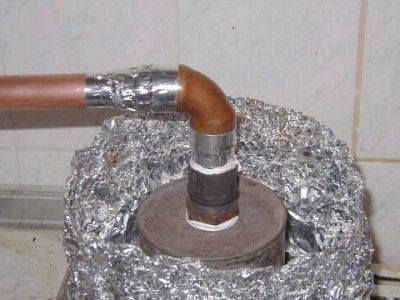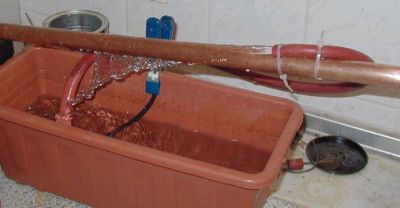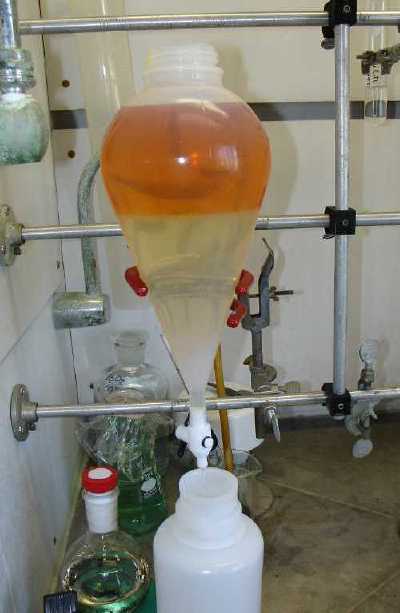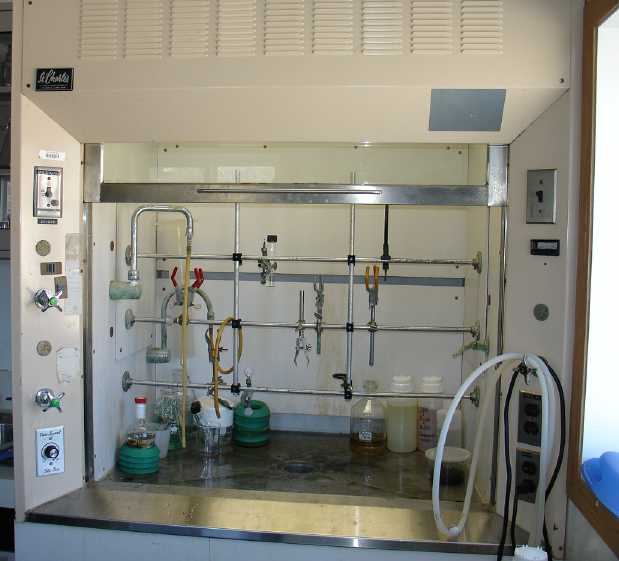| Pages:
1
..
4
5
6
7
8
..
14 |
ordenblitz
Hazard to Others
  
Posts: 259
Registered: 18-7-2004
Location: Northwest
Member Is Offline
Mood: Bohr'd
|
|
Thanks Marvin.
It's all easy if you have the tools. Fortunately for me, I don't have a wife to dictate where the money will be spent therefore I am free to
explore the limits of my chemical dependency as it were.
There is a purge port on the ftir and you are supposed to flush with N2 or dry air. Nitrogen is preferable since this will eliminate both the CO2 and
H2O peaks. I don't use the thing often enough to justify the effort and expense, so I have to apply the appropriate software correction and deal
with some loss of accuracy.
|
|
|
Organikum
resurrected
    
Posts: 2329
Registered: 12-10-2002
Location: Europe
Member Is Offline
Mood: busy and in love
|
|
Marvin, the water is coming from my faucet, just a quick wash with bicarb/brine and I put always some water into my receiving jar for its easier to
see when it starts coming over, dropping.
In the distillation some minimal amounts of water come over, probably from the NaOH sucking water from the air whilst grinding.
Benzoate and grinded NaOH are not ground together, they are merely mixed well, barmixer style.....
Grinding NaOH does not harm my coffee-grinder, benzoate does. Puff and out. Deflagration is the right word I believe, grinding benzoate and NaOH with
mortar and pestle is for masochists and plain not necessary. Gladly I want to add.
ordenblitz, I get the cans when I buy solvents over the street in the paints store, looks like this:
http://www.sciencemadness.org/scipics/solventcans.jpg
And I have more than one, one makes about three to four runs and then its finished.

|
|
|
stygian
Hazard to Others
  
Posts: 242
Registered: 19-9-2004
Member Is Offline
Mood: No Mood
|
|
| Quote: | Originally posted by notagod
If I remeber right, it does'nt have to be benzoic acid, the sodium salt will do. Mix it with waterfree sodium carbonate and heat it gently.
Benzene will distill over. You can also have some sand mixed in to have a more "smooth" reaction. |
Does this mean sodium salicylate + sodium carbonate == phenol? 
|
|
|
Marvin
National Hazard
   
Posts: 995
Registered: 13-10-2002
Member Is Offline
Mood: No Mood
|
|
I'm not convinced by sodium carbonate but salicylic acid decarboxlyates a lot easier than benzene. Its also more, for want of a better word,
fragile. Heating salicylic acid with lime will work, or with plain sand will also work. I dont know what the yeilds are like but yes this will make
phenol.
Organikum, I was wondering if it was washing water, and I couldnt figure out how else such a large molar amount of water would come from, but since
it was just described as the distillate I did wonder.
ordenblitz, I have the main unit of a much older nicolet insument and it has an air bearing! Needs compressed air supply and I dont know what
pressure. No interface card so I cant try it, not sure if it would work or not. I know complete working units (even secondhand) are out of my price
band though. I also bought a dual beam instument on ebay but I was unlucky and everything of value inside had been stripped.
|
|
|
thefips
Harmless

Posts: 33
Registered: 6-3-2004
Location: Germany
Member Is Offline
Mood: self destructive 
|
|
I had an idea,but I don´t know,if it would work.If phthalic anhydride is dissolved in a solvent,phthalic acid can be precipitated by adding
HCl(aq).The structure of phthalic acid is C6H4(COOH)2.If phthalic acid is heated,I think CO2 is released and benzene distills over.But I am not
sure,if it is right.
|
|
|
Organikum
resurrected
    
Posts: 2329
Registered: 12-10-2002
Location: Europe
Member Is Offline
Mood: busy and in love
|
|
Simplified Setup
For not having to use my glassware anymore for the benzene from benzoate synthesis a made this simplified setup from pieces I had around, mostly
coppertube and Teflon-tape.


Works fine. 
|
|
|
S.C. Wack
bibliomaster
    
Posts: 2419
Registered: 7-5-2004
Location: Cornworld, Central USA
Member Is Offline
Mood: Enhanced
|
|
True, but not mentioned before because for most it isn't as cheap, or as easy to buy or make (toluene/KMnO4/Na2CO3).
|
|
|
Organikum
resurrected
    
Posts: 2329
Registered: 12-10-2002
Location: Europe
Member Is Offline
Mood: busy and in love
|
|
Interesting observation with benzoate to benzene
When the product of the sodium-benzoate destructive distillation is NOT washed with water before distillation a clear distillate with a sharp pungent
smell comes over at about 70°C. This is obviously an azeotrope of benzene with an unknown compound.
This compound is water sensible. I say so because of the fizzling sounds which are to notice when the distillate of the benzoate-pyrolysis is
collected in a jar filled with water.
Whats this?
Some anhydride and maybe useful?
Any ideas?
Its not the diphenyl, thats the yellow contamination.
|
|
|
IPN
Hazard to Others
  
Posts: 156
Registered: 31-5-2003
Location: Finland
Member Is Offline
Mood: oxidized
|
|
Nice job with the improvements Organikum. 
This way to benzene seems so easy that someone should document it into a pdf so it will never be lost. 
As a side note I'm really happy with my ~1l of benzene at the moment. 
Azo dyes, here I come!
[Edited on 15.10.2004 by IPN]
|
|
|
Organikum
resurrected
    
Posts: 2329
Registered: 12-10-2002
Location: Europe
Member Is Offline
Mood: busy and in love
|
|
I will compile this pdf document for having the pictures its probably up to me I guess.
no hurry please.
ORG
|
|
|
Blackout
Harmless

Posts: 25
Registered: 26-11-2004
Location: Canada
Member Is Offline
Mood: No Mood
|
|
I want to know if there is a way to extract benzene from polystyrene?
thanks.
\"Si vis pacem, para bellum.\"
\"If you wish for peace, prepare for war.\"
|
|
|
UpNatom
Harmless

Posts: 42
Registered: 2-9-2004
Location: UK
Member Is Offline
Mood: No Mood
|
|
'Extraction' wouldn't be possible. Pyrolysis to styrene, oxidation to benzoic acid and finally decarboxylation to benzene is a viable
synthesis however.
[Edited on 27-11-2004 by UpNatom]
|
|
|
Magpie
lab constructor
    
Posts: 5939
Registered: 1-11-2003
Location: USA
Member Is Offline
Mood: Chemistry: the subtle science.
|
|
I recently decided I needed some benzene so have read this thread with great interest. I have a procedure for decarboxylation of benzoic acid in my
old college lab manual, i.e., "Unitized Experiments in Organic Chemistry," by Brewster et al (1961). It is an abbreviated version of that
in Norris posted by S. C. Wack. The procedure intrigues me as I had never seen a "dry distillation" procedure before. I wondered how it
could work.
I started with Na benzoate (small prills) and Red Devil lye (very small prills).
My first 2 attempts resulted in failure. That is I did the same thing twice and got the same results twice  . Then I decided I wasn't giving it enough heat so bought a new, full propane cylinder and tried it again. This
time I got a few drops of benzene - still a failure. The 4th time I dried the paste mixture of Na benzoate/NaOH/H2O for 2 hours at 100C in an oven
and then ground it to a powder in a mortar & pestle. I then placed half of it in the 25x200mm test tube, keeping it dry with a rubber stopper
until ready for use. Then I really put the heat to it until I could see the NaOH melting and reacting with the Na benzoate. This was effective and
all benzoate reacted leaving just the NaOH, (Na2CO3?), and patches of carbon black. The benzene looked to be in good yield but has an orange color. . Then I decided I wasn't giving it enough heat so bought a new, full propane cylinder and tried it again. This
time I got a few drops of benzene - still a failure. The 4th time I dried the paste mixture of Na benzoate/NaOH/H2O for 2 hours at 100C in an oven
and then ground it to a powder in a mortar & pestle. I then placed half of it in the 25x200mm test tube, keeping it dry with a rubber stopper
until ready for use. Then I really put the heat to it until I could see the NaOH melting and reacting with the Na benzoate. This was effective and
all benzoate reacted leaving just the NaOH, (Na2CO3?), and patches of carbon black. The benzene looked to be in good yield but has an orange color.
The other half of the batch I placed in the 25x200mm test tube with a copper scrub pad. This gave the same result but was harder to observe and
control during heating. I found it notable that the copper pad seemed unaffected by the molten NaOH.
I agree with previous observations that the main issue here is with good heat transfer. When I was just using the paste my heat transfer was
terrible. With the dry powder it lay nicely in the bottom of the horizontal test tube. In a few days I will try a full batch in the test tube.
The waste products in the test tube wash out easily. However, the molten NaOH does permanently etch the test tube somewhat clouding it. But it is
completely reuseable, at least for the this same procedure.
I agree with Marvin and vulture that much satisfaction comes from making useful reagents from OTC ingredients, especialy when it is a challenge. 
When I get access to a scanner I will post my 1961 lab manual to the forum library. It is remarkably different in scope from my current lab manual
(Pavia, Kriz, et al).
[Edited on 11-3-2005 by Magpie]
[Edited on 11-3-2005 by Magpie]
[Edited on 11-3-2005 by Magpie]
[Edited on 11-3-2005 by Magpie]
The single most important condition for a successful synthesis is good mixing - Nicodem
|
|
|
BromicAcid
International Hazard
    
Posts: 3227
Registered: 13-7-2003
Location: Wisconsin
Member Is Offline
Mood: Rock n' Roll
|
|
I also ran across some interesting information that could lead to benzene lately. DMSO decarboxylates a number of compounds at very low temps (~30 -
50C), benzoic acid could be heated with DMSO and benzene would (in theory) continuously distill off, just add more benzoic acid when the distillation
started to slack. You could really get away cheap by oxidizing the toluene yourself with an aquarium pump bubbling air through toluene under water in
the presence of some transition metal catalyst (or so I've been lead to believe).
|
|
|
Organikum
resurrected
    
Posts: 2329
Registered: 12-10-2002
Location: Europe
Member Is Offline
Mood: busy and in love
|
|
Shit, most of my pictures are missing, I will upload them again later.
|
|
|
Magpie
lab constructor
    
Posts: 5939
Registered: 1-11-2003
Location: USA
Member Is Offline
Mood: Chemistry: the subtle science.
|
|
historical reference
I thought it would be interesting to read the original journal article on this method by E. Mitscherlich as published in "Annalen der
Chemie" (1834). I will post it in the original German and hope someone will translate it to English. Sorry I can't post the whole article
but I was getting writer's cramp as it is. My apologies for lack of proper notation on some of the "e's". I hope it is still
translatable. Here is what appears to be the most meaningful excerpt:
Ueber das Benzol und die Sauren der Oel- und Talgarten
Das Benzol (Benzin)
Mengt man Benzoesäure mit einer starken Base, woyon man mehr nimmt als hinreichend ist um die doppelte Menge. Benzoesäure zu sättigen, mengt
man z. B. 1 Th. Benzoesäure mit 3 Th. gelöschter Kalkerde, und unterwirit das Gemenge der Destillation, so geht zuerst Wasser und zuletzt eine
dünnflüssige ölartige Flüssigkeit über, welche auf dem Wasser schwimmt. Wenn man das Gemenge sehr langsam erwarmt, so ist der Rückstand in der
Retorte vollkommen farblos, und läfst beim Auflösen in Säure, wobei sich Kohlensäure entwickelt, keine Spur eines Rückstandes zuruck; die
Auflösung in der Säure ist farblos, und es wird keine Gasart bei der destillation entwickelt. Die Benzoesäure zerlegt sich also in Kohlensäure
und in die ölartige Flüssigkeit. Die ölartige Flüssigkeit kann man vom Wasser vollständig trennen, wenn man sie mit der Pipette abnimmt, dann
mit etwas Kali schüttelt und destilliert. Läftst man Kalium lange Zeit mit dieser Flüssigkeit in Berührung, oder destillirt man sie damit, so
bleibt die Oberfläche des Kaliums metallisch glänzend, so dafs sie also keinen Sauerstoff enthalt. Da diese Flüssigkeit aus der Benzoesäure
gewonnen wird, und wahrscheinlich mit den Benzoylverbindungen im Zusammenhang steht, so gibt man ihr am besten den Namen Benzol, da der Name Benzoyn
shon für die dem Bittermandelöl isomerische Verbinung von Liebig und Wöhler gewählt worden ist.
The single most important condition for a successful synthesis is good mixing - Nicodem
|
|
|
Organikum
resurrected
    
Posts: 2329
Registered: 12-10-2002
Location: Europe
Member Is Offline
Mood: busy and in love
|
|
Mixing benzoic acid and calcium hydroxide 1/3 w/w followed by distillation yields an oily layer on water which is redistilled and the resulting liquid
is christened "benzene" as the name benzoyl was already taken for something else.
/ORG
|
|
|
Magpie
lab constructor
    
Posts: 5939
Registered: 1-11-2003
Location: USA
Member Is Offline
Mood: Chemistry: the subtle science.
|
|
Thanks for the translation abstract organikum. Is the rest of the text irrelevant? If you would have the time I would appreciate a full translation
out of curiosity and historical interest. 
The single most important condition for a successful synthesis is good mixing - Nicodem
|
|
|
Organikum
resurrected
    
Posts: 2329
Registered: 12-10-2002
Location: Europe
Member Is Offline
Mood: busy and in love
|
|
The rest says, that the residue in the retort is colorless, dissolves in acid and CO2 is evolved, the resulting solution is also colorless. The
distillation (of the benzoic acid and calcium hydroxide) produces no gases, ergo the reaction splits CO2 from the benzoic acid.
Potassium added to the benzene keeps its metallic surface, so this "benzene" contains no oxygen.
Thats really all whats written.
|
|
|
ordenblitz
Hazard to Others
  
Posts: 259
Registered: 18-7-2004
Location: Northwest
Member Is Offline
Mood: Bohr'd
|
|
Taking a big jump up in size to see if economy of scale applies in this case, I constructed the following monster distillation setup.
http://img178.imageshack.us/img178/3643/cansetup2jq.jpg
You can see the lead in end of the water jacketed condenser I whipped up for the occasion. Here is the other end in a 2000ml. bottle waiting to
receive its load.
http://img178.imageshack.us/img178/4406/collect3ym.jpg
In the can was put 4 or 5 shredded stainless steel scrubber pads, for a conduction aid and a specially wet granulated, densified and beaded mix of
2500 gm sodium benzoate + 1250 gm calcium hydroxide. I prefer to use Ca(OH)2 since I have to use less personal protection when mixing and granulating.
Clean up is easier and of course the stuff is cheaper.
http://img178.imageshack.us/img178/2382/granulation6yp.jpg
I cranked up this monster and after waiting 3 hours for about 250ml I got frustrated and broke out the Big burner and commenced to roasting that
bastard! You can see I just disconnected the other burner and slipped in the big guns. I had that can pretty red!
http://img178.imageshack.us/img178/9587/bigburn8ic.jpg
After another hour or two, when things started to slow down I shut it down and this is what I got.
http://img178.imageshack.us/img178/308/yellow0fp.jpg
650 stinking milliliters for all that hard work and waiting, pathetic! I expected about 1500ml. After opening the can I noticed that most of the
center of the mass was un-reacted and the top looked all but untouched. I had the lower 1/3 of the can cherry red after the 3rd hour. Organikum was
right on the money about the poor heat conductivity of the reacted mass. I really thought that if I just upped the heat input, I could convince the
thing to happen. Hmm maybe someone should look at this material for heat shielding because it's conductive properties are crap. I think I blew
through a full cylinder of propane doing it.
My conclusion is that scaling this reaction up without a lot of fairly technical hardware, is probably just not worth the effort.
Washed and ready to distill!

|
|
|
12AX7
Post Harlot
    
Posts: 4803
Registered: 8-3-2005
Location: oscillating
Member Is Offline
Mood: informative
|
|
Sounds like you need a refractory lined furnace. 
If conductivity is the problem you say it is, it might be worth say pressing into cakes and/or only using smaller retorts- anything with more surface
area and thinner cross section.
It could well appear to be low in conductivity due to heat consumption as well as insulation; I imagine the reaction is mostly endothermic, especially
with the evaporation. Calcium carbonate powder isn't exactly known for its conductivity, at least as a porous lump.
BTW, can PETE be pyrolyzed/decarboxylated to ethylene/ethane and benzene (or other aromatics)? Plenty of it around. It's a polyester of pthalic
acid and ethylene glycol, plus whatever modifiers they used.
Tim
|
|
|
Magpie
lab constructor
    
Posts: 5939
Registered: 1-11-2003
Location: USA
Member Is Offline
Mood: Chemistry: the subtle science.
|
|
A valiant effort Ordenblitz! Indeed you have confirmed the poor heat transfer inherent in dry powder. What you need is a minature lime kiln with
tilted, rotating cylinder and hanging chains to keep the powder mixed. 
I'm impressed with your equipment framework, stainless steel drain, etc. Is all that your own personal equipment?
The single most important condition for a successful synthesis is good mixing - Nicodem
|
|
|
ordenblitz
Hazard to Others
  
Posts: 259
Registered: 18-7-2004
Location: Northwest
Member Is Offline
Mood: Bohr'd
|
|
(Quote)
---------------------------------------------------
What you need is a miniature limekiln with tilted, rotating
Cylinder and hanging chains to keep the powder mixed.
---------------------------------------------------
That’s a good idea. I could put some ceramic milling media with the feed stock in the cylinder, rotate it for a while to grind everything up nicely
and then turn on the heat. Now all I have to do is figure out some sort of high temp banjo fitting for the out port and I am in the benzene business.
(Quote)
---------------------------------------------------
I'm impressed with your equipment framework, stainless
steel drain, etc. Is all that your own personal equipment?
---------------------------------------------------
Thanks. Yes it's mine. I picked up this hood in a refinery auction for $100 All I had to do was build a pedestal for it and run some duct work to
a restaurant style exhaust fan and viola' The frame is a Fisher monkey bar kit that I installed and even anodized a few of the pieces black. I am
going to do a post about do it yourself anodizing when I get around to it.
I've had quite a few years to put my lab together. Some people have expensive boats or 4 wheelers etc. I have a chemical dependency.
[Edited on 18-7-2005 by ordenblitz]

|
|
|
jimwig
Hazard to Others
  
Posts: 215
Registered: 17-5-2003
Location: the sunny south
Member Is Offline
Mood: No Mood
|
|
Stir it up - but like you say more technical equipment required.
Keep it stirred with a huge mechanical stirrer. Ok stop laughing.
You gotta use stainless as the reaction vessel then put a old speaker magnet on a motor shaft. Plug it into a variac. Use teflon tape coated steel bar
for the stir bar. Maybe an epoxy stir bar would last a short time in the hot alkali.
[Edited on 18-7-2005 by jimwig]
|
|
|
Magpie
lab constructor
    
Posts: 5939
Registered: 1-11-2003
Location: USA
Member Is Offline
Mood: Chemistry: the subtle science.
|
|
$100 for a fume hood! Together with your FTIR spectrometer you have really picked up some bargains. 
I just happened to be in the middle of building a fume hood system in my garage using parts purchased from local non-scientific sources like Home
Depot. I'm using a 475 cfm (@ 0.75" H2O) open one-side blower, SS316 discharge duct, and 8" PVC suction ducting. The hood will be
epoxy coated wood 48" wide x 46" high x 28" deep. It will be a constant volume bypass type using a tempered glass sash with PVC frame.
I had the SS316 discharge piece fabricated by a sheet metal shop. The blower will sit in my rafters. My total cost will be over $1000 just for
materials. 
The single most important condition for a successful synthesis is good mixing - Nicodem
|
|
|
| Pages:
1
..
4
5
6
7
8
..
14 |